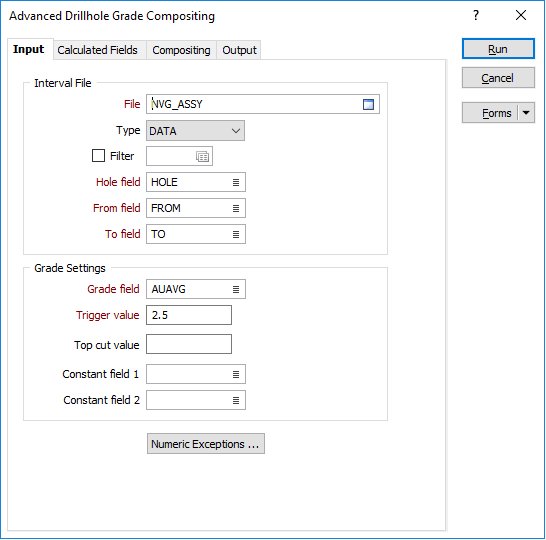Grade Compositing (Advanced)
The Drillhole | Compositing | Grade (Advanced) function allows you to choose more than one compositing method and experiment with advanced waste options. You can set constraints such as the minimum grade (Trigger value), the amount of waste, and the Minimum length of composites, etc. Using these constraints, often in an iterative process, you can locate the zones in an orebody that meet mining or exploration conditions.
The simplest case is to ignore waste altogether and only composite intervals that equal or exceed a minimum length. To do this, you only need to nominate the field containing the grades and specify a Trigger value (on the Input/Output tab of the form) and specify a Minimum length (on the Compositing tab).

When you run the function it produces a Report file. The Report file contains information about the process such as error and warning messages.
Compositing is performed using the grades in a nominated Grade field. Values in the Grade field greater than or equal to the Trigger value will be composited. You can also specify a Top cut value to reduce high grades (applied to the values in the grade field before compositing is performed) and specify Constant fields to force a new composite whenever the value in the field changes.
The Compositing process can also create a new field in the output file and write a grade or waste flag to each interval (record) according to its contents. This enables you to separate grade and waste intervals when you use the output file in other functions.
Nominate a Drillhole Database or a trace coordinate file on the Calculated Fields tab of the form. Specify the names of the required fields if they have not updated automatically. The function needs these fields to calculate the coordinates at the centre of each interval. You can also choose an option to include an updated thickness field in the output file.
Validate all the files you will use as input to this function before running the function. There should be no overlapping intervals, for example. See: Drillhole Validation
Interval File
Double-click (or click on the Select icon) to select the name of the Interval File that contains the data you want to composite and optionally apply a Filter.
Hole, From, and To Fields
In order to composite the data in an Interval file, you need to identify the Hole field and the fields containing the From and To depths that define each interval. Double-click to select each field.
Grade Settings
Grade field
Double-click to select the name of the Grade field containing the values that will used to trigger the compositing process
Trigger value
Enter a Trigger (cutoff) value. This is the minimum grade that must be equalled or exceeded before composites will be formed.
Top cut value
Enter a Top cut value to reduce high grades. For the computation (no changes will be made in the input file) the value you enter will be used in place of all values in the Grade field that exceed it.
Constant fields
(Optionally) Select a constant field to force a new composite whenever the value in that field changes. If you select two Composite fields, a new composite will begin when a value in either field changes.
Numeric Exceptions
(Optional) Use the Numeric Exceptions group to control the way that non-numeric values are handled. Non-numeric values include characters, blanks, and values preceded by a less than sign (<).